Abstract
Samples of mixed liquor were withdrawn from a laboratory-scale activated sludge simulation operated at a range of sludge ages from 3 to 12 days in order to examine the difference in metal uptake by the mixed liquor biomass in the absence and presence of soluble ligands. One half of the samples were centrifuged, washed, and resuspended in physiological saline solution, and the rest were left unchanged. In another experiment, aliquots of synthetic sewage were added to mixed liquor samples to investigate the effect of increased soluble influent sewage ligands on metal uptake.
It was found that at low sludge ages, uptake of metals by biomass was lower in the presence of soluble ligands than in their absence, but as the sludge age increased uptake in the presence of soluble ligands also increased. It is suggested that at low sludge ages, ligands predominantly prevented metal uptake by the biomass by chelating the metals and stabilizing them in solution and, at longer sludge ages, ligands predominantly enhanced uptake. Increasing the concentration of synthetic sewage caused a reduction in metal removal and it is suggested that soluble ligands in the synthetic sewage were responsible for preventing metal uptake.
Similar content being viewed by others
References
Allen HE, Hall RH, Brisbin TD (1980) Metal speciation. Effects on aquatic toxicity. Environ Sci Technol 14:441
Bisogne JJ, Lawrence AW (1971) Relationships between biological solids retention time and settling characteristics of activated sludge. Water Res 5:753
Bourg ACM, Schindler PW (1978) Ternary surface complexes. 1. Complex formation in the system silica-Cu (II)-ethylenediamine. Chimica 32:166
Bourg ACM, Joss S, Schindler PW (1979) Ternary surface complexes. 2. Complex formation in the system silica-Cu (II)-2,21, bipyridyl. Chimica 33:19
Cheng MH, Patterson JW, Minear RA (1975) Heavy metals uptake by activated sludge. J Water Pollut Control Fed 47:362
Davis JA, Leckie JO (1978) Effect of adsorbed complexing ligands on trace metal uptake by hydrous oxides. Environ Sci Technol 12:1309
Elliot HA, Huang CP (1979) The adsorption characteristics of Cu (II) in the presence of chelating agents. J Colloid Interface Sci 70:29
Florence TM (1982) The speciation of trace elements in waters. Talanta 29:345
Friedman BA, Dugan PR (1968) Identification of zoogloea species and the relationship to zoogloeal matrix and floc formation. J Bact 95:1903
Gadd GM, Mowill JL (1983) The relationship between cadmium uptake, potassium release, and viability inSaccharomyces cerevisiae. Microbiol Lett 16:45
Government of Great Britain, Dept. of the Environment (1972) Analysis of raw, potable, and waste waters. H.M.S.O., London
Guthrie RR, Singleton FL, Cherry DS (1977) Aquatic bacterial populations and heavy metals. II. Influence of chemical content of aquatic environments on bacterial uptake of chemical elements. Water Res 8:643
Inoue Y, Munemori M (1979) Coprecipitation of mercury (II) with iron (III) hydroxide. Environ Sci Technol 13:443
Jeffries TW, Butler RG (1975) Growth inhibition ofRhodopseudomonas capsulata by methylmercury acetate. Appl Microbiol 30:156
Johnston R (1964) Seawater, the natural medium of phytoplankton. II. Trace metals and chelation and general discussion. J Mar Biol Assoc U.K. 44:87
Kempton S, Sterritt RM, Lester JN (1982) Atomic-absorption spectrophotometric determination of antimony, arsenic, bismuth, tellurium, thallium and vanadium in sewage sludge. Talanta 29:675
Lawson PL, Sterritt RM, Lester JN (1984) The speciation of metals in sewage and activated sludge effluent. Water Air Soil Pollut 21:387
Loveless JE, Painter HA (1968) The influence of metal in concentrations and pH value on the growth ofNitrosomonas strain isolated from activated sludge. J Gen Microbiol 52:1
MacNaughton MG, James RO (1974) Adsorption of aqueous mercury II complexes at the oxide/water interface. J Colloid Interface Sci 47:431
Neubecker TA, Allen HE (1983) The measurement of complexation capacity and conditional stability constants for ligands in natural waters. Water Res 17:1
Neufeld RD, Herman ER (1975) Heavy metal removal by acclimated activated sludge. J Water Pollut Control Fed 47:310
Perrin DD, Dempsey B (1974) Metal Ion Buffers. Chap. 7. Chapman Hall, London
Pickett AW Dean ACR (1979) Cadmium and zinc sensitivity and tolerance inBacillus subtilis subsp.niger and in aPseudomonas sp. Microbios 24:51
Rossin AC, Sterritt RM, Lester JN (1982) The influence of process parameters on the removal of heavy metals in activated sludge. Water Air Soil Pollut 17:185
Schitzer M (1971) in Faust SD and Hunter JV (eds): Organic compounds in aquatic environments p. 297. M. Dekker, New York
Sprague JB (1968) Promising anti-pollutant chelating agent NTA protects from Cd and Zn. Nature 222: 1344
Sterritt RM, Lester JN (1980) Influence of bacterial growth on the forms of cadmium in defined culture media. Bull Environ Contam Toxicol 24:196
—(1981) The influence of sludge age on heavy metal removal in the activated sludge process. Water Res 15:59
—(1982) Speciation of copper and manganese in effluents from the activated sludge process. Environ Pollut (Ser.A) 27:37
Stoveland S, Lester JN (1980) A study of the factors which influence metal removal in the activated sludge process. Sci Total Environ 16:37
Stumm W, Morgan JJ (1970) Aquatic Chemistry. p. 238. Wiley-Interscience, New York
Tynecka Z, Zajac J, Goś Z (1975) Plasmid dependent impermeability barrier to cadmium ions inStaphylococcus aureus. Acta Microbiol Pol Ser.A 7:11
Van den Berg CMG, Kramer JR (1979) Determination of complexation capacities of ligands in natural waters and conditional stability constants of the copper complexes by means of manganese dioxide. Anal Chim Acta 106:113
Author information
Authors and Affiliations
Rights and permissions
About this article
Cite this article
Lawson, P.S., Sterritt, R.M. & Lester, J.N. Factors affecting the removal of metals during activated sludge wastewater treatment I. The role of soluble ligands. Arch. Environ. Contam. Toxicol. 13, 383–390 (1984). https://doi.org/10.1007/BF01056253
Received:
Revised:
Issue Date:
DOI: https://doi.org/10.1007/BF01056253




